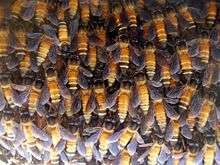Halictidae
| Halictidae | |
|---|---|
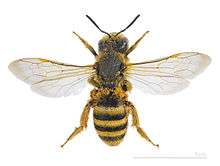 | |
| Halictus scabiosae - MHNT | |
| Scientific classification | |
| Kingdom: | Animalia |
| Phylum: | Arthropoda |
| Subphylum: | Hexapoda |
| Class: | Insecta |
| Order: | Hymenoptera |
| Suborder: | Apocrita |
| Superfamily: | Apoidea |
| Family: | Halictidae Thomson, 1869, nom. protect. |
| Subfamilies | |
| |
The Halictidae is the second largest family of Apoidea bees.[1] Halictid species occur all over the world[2] and are usually dark-colored and often metallic in appearance. Several species are all or partly green and a few are red; a number of them have yellow markings, especially the males, which commonly possess yellow faces, a pattern widespread among the various families of bees.
They are commonly referred to as "sweat bees" (especially the smaller species), as they are often attracted to perspiration.[3] They are likely to sting only if disturbed; the sting is minor.[4]
Ecology
Most halictids nest in the ground, though a few nest in wood, and they mass-provision their young (a mass of pollen and nectar is formed inside a waterproof cell, an egg laid upon it, and the cell sealed off, so the larva is given all of its food at one time, as opposed to "progressive provisioning", where a larva is fed repeatedly as it grows, as in honey bees). All species are pollen feeders and may be important pollinators.

Eusocial species
Many species in the subfamily Halictinae are eusocial at least in part, such as Lasioglossum malachurum or Halictus rubicundus, with fairly well-defined queen and worker castes (though not the same as the caste system in honey bees), and certain manifestations of their social behavior appear to be facultative in various lineages.[5] Those species who do not have a permanent, rigid, division of labor, such as Lasioglossum zephyrum, are considered primitively eusocial.[6] Another example of a primitive eusocial bee species from this family is the Halictus ligatus species, for which aggression is one of the most influential behavioral attitudes for establishing hierarchy and social organization within the colony.[7] Primitively eusocial species such as these provide insight into the early evolution of eusociality.[7] Halictus sexcinctus, which exhibits social, communal, and eusocial organization, provides insight into the evolutionary reversal of eusociality. Phylogenetic data from this species suggests that a communal strategy serves as a transitional step between eusociality and a reversion back to solitary nesting.[8]
Cleptoparasitic species
Several genera and species of halictids are cleptoparasites of other bees (mostly other halictids), and the behavior has evolved at least 9 times independently within the family. The most well-known and common are species in the genus Sphecodes, which are somewhat wasp-like in appearance (often shining black with blood-red abdomen- German: Blutbienen - usually 4–9 mm in body length); the female Sphecodes enters the cell with the provision mass, eats the host egg, and lays an egg of her own in its place.
"Nocturnal" species

Halictidae are one of the four bee families that contain some crepuscular species; these halictids are active only at dusk or in the early evening, so are technically considered "vespertine" (e.g. in the subgenus Sphecodogastra of Lasioglossum), or sometimes truly nocturnal (e.g. in the genus Megalopta, or species Megalopta genalis).[9] These bees, as is typical in such cases, have greatly enlarged ocelli. The other families with some crepuscular species are Andrenidae, Colletidae, and Apidae.
Species of economic importance
Some species are important in the pollination of crops. Among these are the alkali bee,[10] Lasioglossum vierecki[11] and Lasioglossum leucozonium.[12]
Systematics and evolution
The Halictidae belong to the hymenopteran superfamily Apoidea, series Anthophila. The oldest fossil record of Halictidae dates back to Early Eocene[13] with a number of species, such as Neocorynura electra[14] and Augochlora leptoloba[15] known from amber deposits. Currently, the family is divided into four subfamilies, many genera and more than 2000 known species. The Rophitinae appear to be the sister group to the remaining three subfamilies (Nomiinae, Nomioidinae, Halictinae) based on both morphology and molecular data.[16]
Systematics
Rophitinae:
- Ceblurgus
- Conanthalictus
- Dufourea
- Goeletapis
- Micralictoides
- Morawitzella
- Morawitzia
- Penapis
- Protodufourea
- Rophites
- Sphecodosoma
- Systropha
- Xeralictus
Nomiinae:
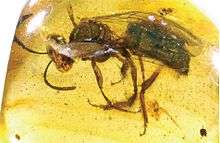
- Dieunomia
- Halictonomia
- Lipotriches
- Mellitidia
- Nomia
- Pseudapis
- Ptilonomia
- Reepenia
- Spatunomia
- Sphegocephala
- Steganomus
Nomioidinae:
- Cellariella
- Ceylalictus
- Nomioides
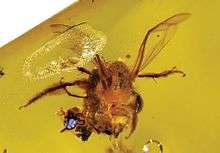
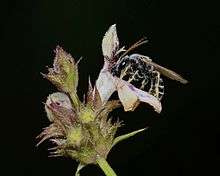
- Tribe Halictini
- Agapostemon
- Caenohalictus
- Dinagapostemon
- Echthralictus
- Eupetersia
- Glossodialictus
- Habralictus
- Halictus
- Homalictus
- Lasioglossum
- Mexalictus
- Microsphecodes
- Nesosphecodes
- Paragapostemon
- Patellapis
- Pseudagapostemon
- Ptilocleptis
- Rhinetula
- Ruizantheda
- Sphecodes
- Thrincohalictus
- Urohalictus
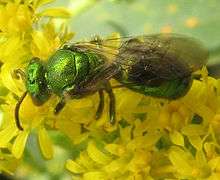
- Tribe Thrinchostomini
- Parathrincostoma
- Thrinchostoma
- Tribe Augochlorini
- Andinaugochlora
- Ariphanarthra
- Augochlora
.jpg)
- Augochlorella
- Augochlorodes
- Augochloropsis
- Caenaugochlora
- Chlerogas
- Chlerogella
- Chlerogelloides
- Corynura
- Halictillus
- Ischnomelissa
- Megalopta
- Megaloptidia
- Megaloptilla
- Megommation
- Micrommation
- Neocorynura
- Paroxystoglossa
- Pseudaugochlora
- Rhectomia
- Rhinocorynura
- Temnosoma
- Thectochlora
- Xenochlora
- Tribe unknown
References
- ↑ Danforth, Bryan N.; Cardinal, Sophie; Praz, Christophe; Almeida, Eduardo A.B.; Michez, Denis (2013). "The Impact of Molecular Data on Our Understanding of Bee Phylogeny and Evolution". Annual Review of Entomology. 58 (1): 57–78. doi:10.1146/annurev-ento-120811-153633. ISSN 0066-4170.
- ↑ Pesenko, Yu. A. (1999). "Phylogeny and Classification of the family Halictidae Revised (Hymenoptera: Apoidea)". Journal of the Kansas Entomological Society. 72 (1): 104–123. doi:10.2307/25085883. Retrieved 15 September 2013.
- ↑ "Sweat Bees". Missouri Department of Conservation.
- ↑ "Family Halictidae - Sweat Bees". Bug Guide. Retrieved 29 July 2015.
- ↑ Yanega, D. (1993-06-01). "Environmental influences on male production and social structure inHalictus rubicundus (Hymenoptera: Halictidae)". Insectes Sociaux. 40 (2): 169–180. doi:10.1007/BF01240705. ISSN 0020-1812.
- ↑ Batra, S. W. T. 1966. The life cycle and behavior of the primitively social bee Lasioglossum zephyrum (Halictidae). Univ. Kansas Sci. Bull. 46:359–423.
- 1 2 Pabalan, N., K.G. Davey, and L. Packer. "Escalation of Aggressive Interactions During Staged Encounters in Halictus ligatus Say (Hymenoptera: Halictidae), with a Comparison of Circle Tube Behaviors with Other Halictine Species'." Journal of Insect Behavior 13.5 (2000): 627-650.
- ↑ Richards, M. H. (2003). Variable worker behaviour in the weakly eusocial sweat bee, Halictus sexcinctus Fabricius. Insectes Sociaux, 50(4), 361–364. doi:10.1007/s00040-003-0691-3
- ↑ Greiner, Birgit; Ribi, Willi A.; Warrant, Eric J. (2004-04-03). "Retinal and optical adaptations for nocturnal vision in the halictid bee Megalopta genalis". Cell and Tissue Research. 316 (3): 377–390. doi:10.1007/s00441-004-0883-9. ISSN 0302-766X.
- ↑ "A native ground nesting bee, Nomia melanderi, sustainably managed to pollinate alfalfa across an intensively agricultural landscape)". United States Department of Agriculture - Agricultural Research Service.
- ↑ Kuehn, F. (2015). "Farming for native bees: Final report". SARE - Sustainable agriculture research & education.
- ↑ Adamson, N. L. (2011). An assessment of non-Apis bees as fruit and vegetable crop pollinators in southwest Virginia (PDF) (PhD). Virginia Polytechnic Institute and State University.
- ↑ Engel, M.S., Archibald, S.B. An Early Eocene bee (Hymenoptera: Halictidae) from Quilchena, British Columbia. The Canadian Entomologist, Vol. 135, No. 1, 2003
- ↑ Engel, M.S. (1995). "Neocorynura electra, a New Fossil Bee Species from Dominican Amber (Hymenoptera:Halictidae)". Journal of the New York Entomological Society. 103 (3): 317–323. JSTOR 25010174.
- ↑ Engel, M.S. (2000). "Classification of the bee tribe Augochlorini (Hymenoptera, Halictidae)" (PDF). Bulletin of the American Museum of Natural History. 250.
- ↑ Patiny, S. et al., Phylogenetic relationships and host-plant evolution within the basal clade of Halictidae (Hymenoptera, Apoidea). Cladistics 24 (2008) 255–269
External links
| Wikimedia Commons has media related to Halictidae. |
| Wikispecies has information related to: Halictidae |
- Family Halictidae Large format diagnostic photos, information.
- Everything About the Sweat Bee - Description and photo of the sweat bee.
- Image Gallery from Gembloux
- BugGuide – Search: Halictidae (North American species only).
- Online identification guides for eastern North American Halictidae
- Halictidae on the UF / IFAS Featured Creatures Web site
